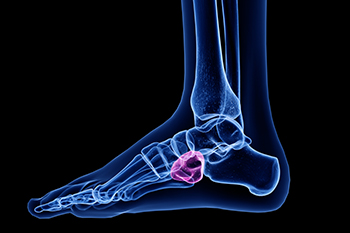
Dr. Kenneth Rosenthal
Dr. Jonathan C. O’Quinn
Dr. Michael J. Price

Dr. Kenneth Rosenthal
Dr. Jonathan C. O’Quinn
Dr. Michael J. Price

Patients that have cuboid syndrome often experience an injury that can lead to this condition. It occurs when the surrounding ligaments of the cuboid bone become inflamed, which can cause pain and discomfort. The cuboid bone is found on the outside of the foot, and is one of the seven tarsal bones. This foot condition can be common among athletes and ballet dancers, and can be the result of repetitive movement. The cuboid bone helps to stabilize the foot, and enables comfortable walking. Additionally, it aids in the ability to point and flex, and this is necessary in completing daily activities. It can become injured for a variety of reasons. These can include enduring a severe foot injury, having a sprained ankle, or possibly from running barefoot. People who are overweight or wear shoes that do not fit correctly may be prone to developing cuboid syndrome. Mild relief may be found when the affected foot is rested, and this may help to heal the tissues surrounding the cuboid bone. If you have pain on the outside of your foot, please schedule an appointment with a podiatrist who can properly diagnose and treat cuboid syndrome.
Cuboid syndrome, also known as cuboid subluxation, occurs when the joints and ligaments near the cuboid bone in the foot become torn. If you have cuboid syndrome, consult with one of our podiatrists from Eastern Carolina Foot & Ankle Specialists. Our doctors will assess your condition and provide you with quality foot and ankle treatment.
Cuboid syndrome is a common cause of lateral foot pain, which is pain on the outside of the foot. The condition may happen suddenly due to an ankle sprain, or it may develop slowly overtime from repetitive tension through the bone and surrounding structures.
Causes
The most common causes of cuboid syndrome include:
Symptoms
A common symptom of cuboid syndrome is pain along the outside of the foot which can be felt in the ankle and toes. This pain may create walking difficulties and may cause those with the condition to walk with a limp.
Diagnosis
Diagnosis of cuboid syndrome is often difficult, and it is often misdiagnosed. X-rays, MRIs and CT scans often fail to properly show the cuboid subluxation. Although there isn’t a specific test used to diagnose cuboid syndrome, your podiatrist will usually check if pain is felt while pressing firmly on the cuboid bone of your foot.
Treatment
Just as the range of causes varies widely, so do treatments. Some more common treatments are ice therapy, rest, exercise, taping, and orthotics.
If you have any questions, please feel free to contact our office located in Greenville, NC . We offer the newest diagnostic and treatment technologies for all your foot care needs.